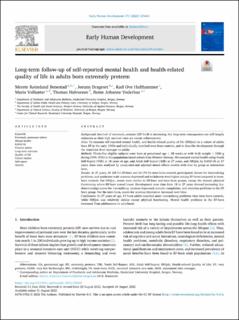Long-term follow-up of self-reported mental health and health-related quality of life in adults born extremely preterm
Benestad, Merete; Drageset, Jorunn; Hufthammer, Karl Ove; Vollsæter, Maria; Halvorsen, Thomas; Vederhus, Bente Johanne
Journal article, Peer reviewed
Published version

Åpne
Permanent lenke
https://hdl.handle.net/11250/3037123Utgivelsesdato
2022Metadata
Vis full innførselSamlinger
Sammendrag
Background Survival of extremely preterm (EP) birth is increasing, but long-term consequences are still largely unknown as their high survival rates are recent achievements. Aims To examine self-reported mental health, and health related quality of life (HRQoL) in a cohort of adults born EP in the early 1990s and individually matched term-born controls, and to describe development through the transition from teenager to adults. Methods Thirty-five eligible subjects were born at gestational age ≤ 28 weeks or with birth weight ≤ 1000 g during 1991–1992 in this population-based cohort from Western Norway. We assessed mental health using Youth Self-Report (YSR) at 18 years of age, and Adult Self-Report (ASR) at 27 years, and HRQoL by RAND-36 at 27 years. Data were analysed by unadjusted and adjusted mixed effects models with time by group as interaction term. Results At 27 years, 24 (69 %) EP-born and 26 (74 %) term-born controls participated. Scores for internalising problems, and syndrome scale anxious/depressed and withdrawn were higher among EP-born compared to term-born controls. For HRQoL, scores were similar in EP-born and term-born groups, except the domain physical functioning where EP-born scored lower. Development over time from 18 to 27 years showed increasing (i.e. deteriorating) scores for internalising, anxious/depressed, somatic complaints, and attention problems in the EP born group. For the term-born, scores for anxious/depression increased over time. Conclusions At 27 years of age, EP-born adults reported more internalising problems than term-born controls, while HRQoL was relatively similar except physical functioning. Mental health problems in the EP-born increased from adolescence to adulthood.
